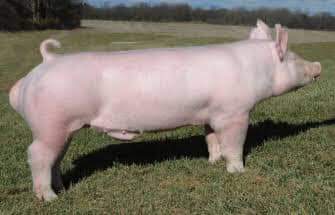Care of breeding boar
By Dr Parvinder kaur Lubana.
So far as overall improvement is concerned, a boar has far more influence in a herd than the average sow. Because a boar has such a tremendous influence within a herd, careful consideration should be given to his selection, management and replacement. On many farms productivity and profitability are reduced because too little consideration is given to developing a suitable breeding program to utilise boars to their full potential.
Selection of boars
A boar must possess both the genetic potential to improve the performance of his progeny, and the physical soundness to remain an active breeder. Final selection for young boars can be carried out when they complete their performance testing between 20 and 30 weeks of age.
Production performance
The production characters of growth rate and carcase quality are of intermediate to high heritability, and a high proportion of the boar’s superiority will be displayed in his offspring.
However, it is unwise to purchase boars from apparently superior herds that are not performance tested. Ask to see the boar’s performance test results and check them against other boars in the same test group — better still if there are estimated breeding values (EBVs) available for the boars. Otherwise, differences in performance could be due to non-genetic effects like environmental factors and these cannot be passed onto a boar’s progeny. Cross-herd evaluations of sire lines are also available.
Health status
The introduction of diseased stock poses the biggest threat to the herd’s current health status. Boars should only be brought in from known healthy herds, and where possible some guarantee obtained as to their freedom from certain diseases, or parasites. A disease outbreak could cause unnecessary hardship and serious economic loss. Ask your veterinary practitioner to liaise with the breeding company to compare your health status. A period of quarantine (4–6 weeks) and acclimatisation provides insurance against new diseases being introduced and allows new boars to be exposed and gain immunity to diseases on your unit. Consult your veterinary practitioner for development of a suitable program.
Conformation and physical soundness
Particular attention should be given to the boar’s legs and feet as they are subjected to considerable strain during mating. Any sign of weakness at this early age could signal a serious problem at a later date.
Make sure that his toes and pasterns are not long, weak or misshapen. When he walks, he should move freely, without any sign of stiffness or lameness. The testes should be normal in shape and size, even, and free from defects. While the width of the testes is directly related to total sperm output, it is not a true indication of the libido or sexual activity of the boar.
Physical contact
Recent research has shown that up to about 30 weeks of age, young boars need contact, particularly physical contact, with other pigs in order to develop high serving performance. After puberty, it is important to house boars near female pigs to maintain courting and serving behaviour. These females can be either oestrus or non-oestrus gilts or sows but must be housed next to the boar pen.
Boar sow ratio
This is usually one boar per 20 sows with supervised hand matings, but in small herds or under extensive conditions, the ratio could be between 15 and 18 sows per boar. This is only a guide for determining the number of boars required. Actual boar requirements would have to be determined for each herd, based on the number of sows to be mated in a given period and the boar’s replacement age. Where double or triple matings are practised, boar requirements are based on the number of sows to be mated per week. With batch farrowing the number of boars required will depend on the batch sizes selected. Obviously where artificial insemination is utilised, fewer boars are required.


